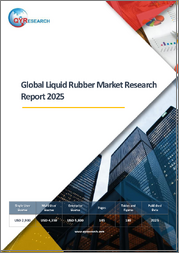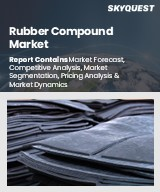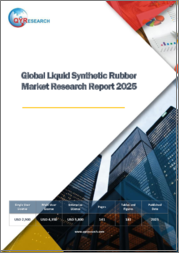
|
시장보고서
상품코드
1603463
세계의 합성고무 시장 규모, 점유율, 성장 분석 : 유형별, 형태별, 용도별, 지역별 - 산업 예측(2024-2031년)Synthetic Rubber Market Size, Share, Growth Analysis, By Type (Styrene butadiene rubber, Polybutadiene Rubber), By Form (Solid, liquid), By Application (Tire, Automotive), By Region - Industry Forecast 2024-2031 |
||||||
세계의 합성고무 시장 규모는 2022년에 288억 9,000만 달러로 평가되었습니다. 2023년 298억 6,000만 달러에서 2031년까지는 417억 3,000만 달러로 성장하고, 예측 기간(2024-2031년) CAGR은 4.9%를 나타낼 전망입니다.
합성고무 시장은 특히 타이어, 씰, 호스, 바닥재 등 자동차 산업에서의 광범위한 응용으로 인해 큰 성장이 예상됩니다. 합성고무는 천연고무에 비해 열 안정성과 내유성이 뛰어나 제품의 신뢰성을 높이는 유리한 특성을 가지고 있습니다. 또한, 산소나 오존과 같은 산화제에 강해 타이어를 비롯한 주요 부품의 수명을 연장할 수 있습니다. 고품질 고무 제품에 대한 수요 증가는 제품 혁신과 개선을 위한 제조업체의 연구개발 노력 증가에 힘입은 바 큽니다. 또한, 항공우주, 자동차, 건설 등 급성장하는 분야, 특히 타이어 및 전자제품 분야에서 고무 수요 증가에 기여하고 있습니다. 자동차 산업이 OEM 타이어 수요 증가로 인해 강력한 성장세를 보이고 있는 가운데, 합성고무는 이러한 수요를 충족시키는 데 중요한 역할을 할 것으로 예상되며, 궁극적으로 시장 확대를 촉진할 것으로 보입니다. 이러한 추세는 향후 몇 년동안 합성고무 시장의 유망한 전망을 시사합니다.
목차
서론
- 조사 목적
- 조사 범위
- 정의
조사 방법
- 정보 조달
- 2차 데이터와 1차 데이터 방법
- 시장 규모 예측
- 시장 전제조건과 제한
주요 요약
- 세계 시장 전망
- 공급과 수요 동향 분석
- 부문별 기회 분석
시장 역학과 전망
- 시장 개요
- 시장 규모
- 시장 역학
- 성장 촉진요인과 기회
- 성장 억제요인과 과제
- Porter's Five Forces 분석과 영향
- 경쟁 기업간 경쟁 관계
- 대체품의 위협
- 바이어의 교섭력
- 신규 진출업체의 위협
- 공급 기업의 교섭력
주요 시장 인사이트
- 주요 성공 요인
- 경쟁 정도
- 주요 투자 기회
- 시장 생태계
- 기술 진보
- 규제 상황
- 사례 연구 분석
- 특허 분석
- PESTEL 분석
- 거시경제 지표
- 무역 분석
- 시장의 매력 지수
- 원재료 분석
- 공급망 분석
- 가격 분석
세계의 합성고무 시장 규모 : 유형별·CAGR(2024년-2031년)
- 스티렌 부타디엔 고무
- 폴리 부타디엔 고무
- 스티렌 블록 공중합체
- 에틸렌 프로필렌 고무
- 부틸 고무
- 아크릴로니트릴 부타디엔 고무
세계의 합성고무 시장 규모 : 형태별·CAGR(2024년-2031년)
- 액체 합성고무
- 고체 합성고무
세계의 합성고무 시장 규모 : 용도별·CAGR(2024년-2031년)
- 타이어
- 자동차(타이어 이외)
- 신발
- 산업 제품
- 소비재
- 섬유
- 기타
세계의 합성고무 시장 규모 : 지역별·CAGR(2024년-2031년)
- 북미
- 미국
- 캐나다
- 유럽
- 영국
- 독일
- 스페인
- 프랑스
- 이탈리아
- 기타 유럽
- 아시아태평양
- 중국
- 인도
- 일본
- 한국
- 기타 아시아태평양
- 라틴아메리카
- 브라질
- 기타 라틴아메리카
- 중동 및 아프리카
- GCC 국가
- 남아프리카공화국
- 기타 중동 및 아프리카
경쟁 정보
- 주요 5개사 비교
- 주요 기업의 시장 포지셔닝(2023년)
- 주요 시장 기업이 채택한 전략
- 시장 최근 동향
- 기업의 시장 점유율 분석(2023년)
- 주요 기업 개요
- 기업 개요
- 제품 포트폴리오 분석
- 기업 부문별 점유율 분석
- 전년대비 매출 비교(2021-2023년)
주요 기업 개요
- Lanxess AG
- ExxonMobil Corporation
- The Dow Chemical Company
- Sinopec Corporation
- Kumho Petrochemical Co., Ltd.(Kumho Asiana Group)
- Zeon Corporation
- LG Chem Ltd.
- TSRC Corporation
- Sumitomo Chemical Co., Ltd.
- Synthos S.A.
- Trinseo S.A.
- Arlanxeo Holding B.V.
- China National Petroleum Corporation(CNPC)
- Asahi Kasei Corporation
- Nizhnekamskneftekhim PJSC
- Formosa Plastics Corporation
- PetroChina Company Limited
- Thai Rubber Latex Corporation
결론과 제안
LSH 24.12.18Global Synthetic Rubber Market size was valued at USD 28.89 billion in 2022 and is poised to grow from USD 29.86 billion in 2023 to USD 41.73 billion by 2031, growing at a CAGR of 4.9% in the forecast period (2024-2031).
The synthetic rubber market is poised for significant growth, particularly driven by its extensive applications within the automotive industry, such as in tires, seals, hoses, and flooring. With advantageous properties that enhance product reliability, synthetic rubber offers superior thermal stability and oil resistance compared to natural rubber. Its resilience against oxidizing agents like oxygen and ozone helps prolong the shelf-life of critical components, notably tires. The rising demand for high-quality rubber products is fueled by increased research and development efforts from manufacturers aiming to innovate and improve product offerings. Additionally, burgeoning sectors like aerospace, automotive, and construction are contributing to a heightened demand for rubber, particularly in tire and electronic applications. As the automotive industry experiences robust growth spurred by rising OEM tire demand, synthetic rubber is expected to play a crucial role in meeting this need, ultimately propelling market expansion. The convergence of these trends suggests a promising outlook for the synthetic rubber market in the coming years, as industries continue to seek durable and reliable materials to support their product lines.
Top-down and bottom-up approaches were used to estimate and validate the size of the Global Synthetic Rubber market and to estimate the size of various other dependent submarkets. The research methodology used to estimate the market size includes the following details: The key players in the market were identified through secondary research, and their market shares in the respective regions were determined through primary and secondary research. This entire procedure includes the study of the annual and financial reports of the top market players and extensive interviews for key insights from industry leaders such as CEOs, VPs, directors, and marketing executives. All percentage shares split, and breakdowns were determined using secondary sources and verified through Primary sources. All possible parameters that affect the markets covered in this research study have been accounted for, viewed in extensive detail, verified through primary research, and analyzed to get the final quantitative and qualitative data.
Global Synthetic Rubber Market Segmental Analysis
Global Synthetic Rubber Market is segmented by Type, by Form, by Application, and by Region. Based on Type, the market is segmented into Styrene butadiene rubber, Polybutadiene Rubber, Styrene block copolymer, Ethylene-propylene-diene rubber, Butyl rubber, and Acrylonitrile-butadiene rubber. Based on form, the market is segmented into Liquid Synthetic Rubber, and Solid Synthetic Rubber. Based on Application, the market is segmented into Tire, Automotive (Non-tire), Footwear, Industrial Goods, Consumer Goods, Textiles, and Others. Based on region, the market is segmented into North America, Europe, Asia Pacific, Latin America and Middle East & Africa.
Driver of the Global Synthetic Rubber Market
The global synthetic rubber market is experiencing significant growth, primarily fueled by rising demand within the footwear industry. Various types of footwear, ranging from specialized protective options to casual leisure shoes, require diverse materials for production, with synthetic rubber being a preferred choice for creating shoe soles. This preference is largely due to its outstanding physical properties, which include excellent abrasion and durability, tensile strength, slip resistance, and tear strength. Additionally, synthetic rubber can be easily molded into various colors, further enhancing its appeal within the footwear sector and driving an increase in global demand for synthetic rubber products.
Restraints in the Global Synthetic Rubber Market
The growth of the global synthetic rubber market is being hindered by environmental regulations and health concerns associated with its production. Stringent regulations aimed at minimizing environmental impact have restricted the operations within the synthetic rubber industry. According to the Environmental Protection Agency (EPA), rubber processing, sealant manufacturing, and tire production facilities are among the primary contributors to harmful pollutants. These challenges not only pose compliance issues for manufacturers but also raise health and safety concerns, ultimately affecting the market's expansion and innovation potential as companies strive to adhere to these increasingly rigorous environmental standards.
Market Trends of the Global Synthetic Rubber Market
The Global Synthetic Rubber market is witnessing a pronounced trend driven primarily by the tire and tire components sector, which commands the largest market share. Styrene-butadiene rubber (SBR) is increasingly favored for its exceptional abrasion resistance and ageing stability, solidifying its status as the preferred material in tire manufacturing. As automotive industries, particularly in emerging markets, ramp up production and demand for high-performance tires, the synthetic rubber market is poised for robust growth. Additionally, shifts towards eco-friendly alternatives and sustainable practices are influencing innovation, as manufacturers explore bio-based and recycled synthetic rubber options to meet evolving consumer preferences and regulatory requirements.
Table of Contents
Introduction
- Objectives of the Study
- Scope of the Report
- Definitions
Research Methodology
- Information Procurement
- Secondary & Primary Data Methods
- Market Size Estimation
- Market Assumptions & Limitations
Executive Summary
- Global Market Outlook
- Supply & Demand Trend Analysis
- Segmental Opportunity Analysis
Market Dynamics & Outlook
- Market Overview
- Market Size
- Market Dynamics
- Driver & Opportunities
- Restraints & Challenges
- Porters Analysis & Impact
- Competitive rivalry
- Threat of substitute
- Bargaining power of buyers
- Threat of new entrants
- Bargaining power of suppliers
Key Market Insights
- Key Success Factors
- Degree of Competition
- Top Investment Pockets
- Market Ecosystem
- Technological Advancement
- Regulatory Landscape
- Case Study Analysis
- Patent Analysis
- PESTEL Analysis
- Macro-Economic Indicators
- Trade Analysis
- Market Attractiveness Index
- Raw Material Analysis
- Supply Chain Analysis
- Pricing Analysis
Global Synthetic Rubber Market Size by Type & CAGR (2024-2031)
- Styrene butadiene rubber
- Polybutadiene Rubber
- Styrene block copolymer
- Ethylene-propylene-diene rubber
- Butyl rubber
- Acrylonitrile-butadiene rubber
Global Synthetic Rubber Market Size by Form & CAGR (2024-2031)
- Liquid Synthetic Rubber
- Solid Synthetic Rubber
Global Synthetic Rubber Market Size by Application & CAGR (2024-2031)
- Tire
- Automotive (Non-tire)
- Footwear
- Industrial Goods
- Consumer Goods
- Textiles
- Others
Global Synthetic Rubber Market Size by Region & CAGR (2024-2031)
- North America, (by Type, by Form, by Application)
- US
- Canada
- Europe, (by Type, by Form, by Application)
- UK
- Germany
- Spain
- France
- Italy
- Rest of Europe
- Asia-Pacific, (by Type, by Form, by Application)
- China
- India
- Japan
- South Korea
- Rest of Asia Pacific
- Latin America, (by Type, by Form, by Application)
- Brazil
- Rest of Latin America
- Middle East & Africa, (by Type, by Form, by Application)
- GCC Countries
- South Africa
- Rest of Middle East & Africa
Competitive Intelligence
- Top 5 Player Comparison
- Market Positioning of Key Players, 2023
- Strategies Adopted by Key Market Players
- Recent Developments in the Market
- Company Market Share Analysis, 2023
- Company Profiles of All Key Players
- Company Details
- Product Portfolio Analysis
- Company's Segmental Share Analysis
- Revenue Y-O-Y Comparison (2021-2023)
Key Company Profiles
- Lanxess AG
- Company Overview
- Business Segment Overview
- Financial Updates
- Key Developments
- ExxonMobil Corporation
- Company Overview
- Business Segment Overview
- Financial Updates
- Key Developments
- The Dow Chemical Company
- Company Overview
- Business Segment Overview
- Financial Updates
- Key Developments
- Sinopec Corporation
- Company Overview
- Business Segment Overview
- Financial Updates
- Key Developments
- Kumho Petrochemical Co., Ltd. (Kumho Asiana Group)
- Company Overview
- Business Segment Overview
- Financial Updates
- Key Developments
- Zeon Corporation
- Company Overview
- Business Segment Overview
- Financial Updates
- Key Developments
- LG Chem Ltd.
- Company Overview
- Business Segment Overview
- Financial Updates
- Key Developments
- TSRC Corporation
- Company Overview
- Business Segment Overview
- Financial Updates
- Key Developments
- Sumitomo Chemical Co., Ltd.
- Company Overview
- Business Segment Overview
- Financial Updates
- Key Developments
- Synthos S.A.
- Company Overview
- Business Segment Overview
- Financial Updates
- Key Developments
- Trinseo S.A.
- Company Overview
- Business Segment Overview
- Financial Updates
- Key Developments
- Arlanxeo Holding B.V.
- Company Overview
- Business Segment Overview
- Financial Updates
- Key Developments
- China National Petroleum Corporation (CNPC)
- Company Overview
- Business Segment Overview
- Financial Updates
- Key Developments
- Asahi Kasei Corporation
- Company Overview
- Business Segment Overview
- Financial Updates
- Key Developments
- Nizhnekamskneftekhim PJSC
- Company Overview
- Business Segment Overview
- Financial Updates
- Key Developments
- Formosa Plastics Corporation
- Company Overview
- Business Segment Overview
- Financial Updates
- Key Developments
- PetroChina Company Limited
- Company Overview
- Business Segment Overview
- Financial Updates
- Key Developments
- Thai Rubber Latex Corporation
- Company Overview
- Business Segment Overview
- Financial Updates
- Key Developments



















